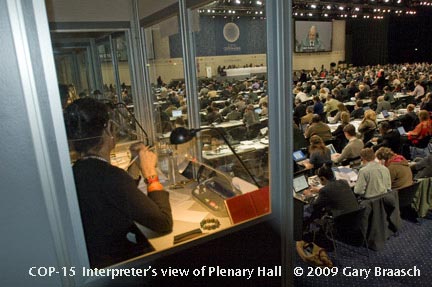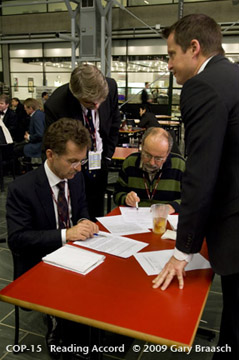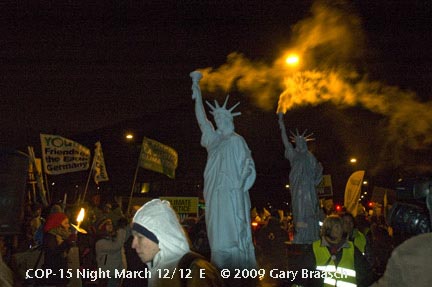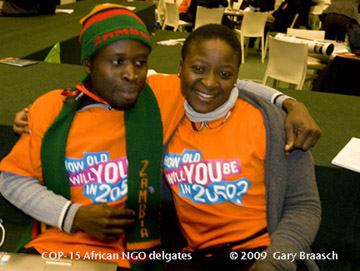Copenhagen. Sunday December 20, 2009
At the eleventh hour of the UN climate talks in Copenhagen, after 14 days of frustrating negotiation, contention, oration, and demonstration, personal negotiations between U.S. and Chinese leaders created an unexpected and possibly breakthrough outcome. Most of the 35,000 registered attendees gathered for the last two weeks were hopeful, but concerned throughout the COP-15 that no strong, legal agreement would be reached. This turned out to be true. On Saturday, the conference ended with a short note on the UN climate convention website, signaling both the lack of a binding agreement and a new direction for the major greenhouse polluters:
Advance unedited versionThat is the entire official record of the action, or as many saw it, inaction, taken by COP-15 on an international plan to reduce greenhouse emissions. The Conference of the Parties (COP), this huge meeting of 193 nations, the governing body of the UN climate convention, ended its long anticipated fifteenth meeting in Copenhagen without a negotiated, agreed to, and binding decision on firm targets, dates, and financing for slowing global warming.
Decision -/CP.15
The Conference of the Parties
Takes note of the Copenhagen Accord of 18 December 2009.
“Takes note of …” means the COP recognizes that the three-page Copenhagen Accord, which President Barack Obama and leaders of China, India, South Africa, and Brazil agreed to on Friday but did not sign, has been proposed as a plan. Climate convention Secretary Yvo DeBoer called it a letter of intent. Negotiations based on it (and possibly on other proposals, such as the much more stringent limits proposed by
 Tuvalu and the African and island states) are to proceed through 2010. A final consensus decision with binding targets and dates will have to wait at least another year, until the COP meeting currently scheduled for next fall in Mexico. Many nations and human rights and environmental groups expressed their frustration over this delay; signs appeared around the halls: "Not Done Yet."
Tuvalu and the African and island states) are to proceed through 2010. A final consensus decision with binding targets and dates will have to wait at least another year, until the COP meeting currently scheduled for next fall in Mexico. Many nations and human rights and environmental groups expressed their frustration over this delay; signs appeared around the halls: "Not Done Yet."However COP-15 was successful in a very important way: Friday’s dramatic arrival and 13-hour involvement by President Obama, the presence of China’s Premier Wen Jiabao and of more than 100 other world leaders -- and the fact that major nations including the U.S. and China finally have acknowledged the urgency and stated some national goals to limit climate change -- are the most important advances in the international reaction to global warming since the Kyoto Protocol.
In the words of the Accord: “We agree that deep cuts in global emissions are required according to science, and as documented by the IPCC Fourth Assessment Report with a view to reduce global emissions so as to hold the increase in global temperature below 2 degrees Celsius, and take action to meet this objective consistent with science and on the basis of equity.”
Before the COP officially ended on Saturday afternoon, many nations indicated that they want to be associated with this plan, agreed to in impromptu meetings between the leaders of just the U.S., China, India, South Africa, and Brazil. The Accord thus partly rescued what had until Friday been a stalled, fractured, and contentious two weeks.
However, how this new Accord is going to drive the world's response to climate change is in question, because it is seriously underpowered. The promises of the major polluting nations and proposals of the Accord fall very short of stopping many very dangerous global warming effects. President Obama acknowledged this in his closing press briefing. Environmentalists earlier had circulated a leaked United Nations analysis of the major proposals presented at COP-15, which said “global emissions will remain on an unsustainable pathway" that could lead to an additional 2.2 o C / 4 o F temperature rise from today.

To read more about the COP-15, continue below and visit the Yale Forum on Climate Change and the Media, http://www.yaleclimatemediaforum.org
Click on this image to go to photo pages
Copenhagen, Friday, December 18, 2009
As the end of the COP-15 climate talks in Copenhagen neared on Thursday, officials cleared the halls of most of the thousands of non-governmental and civic group members, apparently acceding to the security demands of the presidents and prime ministers who were due to speak over the next two days. President Obama is due Friday; China's Wen Jibao was here today.
There were many calls to "Follow the science," from national delegations and environmentalists alike, to insure that any agreement actually would lead to a sharp change in emissions and lower temperatures. The alarms about the dire effects of global warming already evident have been sounding from many prominent scientists. Dr. Jane Lubchenco, oceanographer and now head of NOAA, told not only of the effects science knew to expect such as rising sea level and water temperatures, but also the changes that were unexpected. She warned of new dead zones in coastal waters from decreases in oxygen in the water, and acidification, a serious change in ocean chemistry from the huge amount of CO2 being absorbed by the seas.
Coral reef scientist Ove Hoegh-Guldberg of Australia told me that we have already lost 20 to 30 percent of corals worldwide and that it looked like 70 percent would be gone by mid century. At a major briefing for the press, leaders of the Intergovernmental Panel on Climate Change (IPCC) said there had already been "unprecedented changes in the climate system." "CO2 remains in the atmosphere for 1000s of years," read one slide, "causing irreversible changes in the climate and ocean chemistry."
Other scientists, with an eye toward the stalled and compromised agreement from the COP-15 talks, warned that CO2 emissions were "completely out of control" and that there were only "rapidly narrowing options" to slow or stop the negative affects of global warming. Economist and scientist Dr. Richard England of the University of New Hampshire said estimates are there is still time to stop greenhouse gases before reaching what many believe to be the brink of widespread disastrous change -- but at the current rate we have only 20 years before we exceed this limit. We are, he said, moving rapidly "beyond the limit we have experienced on this planet during the civilized era."
Unfortunately, the leading proposals from the nations gathered here were far from enough to keep from breaching some of these limits, according to analysis provided by scientific groups. The major nations say they are aimed at not exceeding 450 parts per million of CO2 in the air and an additional increase in average world temperature of about 1.2 degrees C / more than 2 degrees F. However it appears the COP proposals will not be enough to stop there, and also may not be measurable, reportable and verifiable so we can actually see how we are doing. The science increasingly shows that CO2 levels must DECREASE within only a few decades. Tuvalu and other small and low-lying nations brought a proposal to limit at 350 ppm and no more than an additional 1.3 degrees F. Unchecked, the "out of control" rise of CO2 we are producing now may result in 7 to 10 degrees of additional heat by 2100. The world currently is at 387 ppm of CO2 and has experienced about .8 deg C / 1.4 degrees F rise in average surface temperature since the mid 1800s. The current decade is the hottest in the entire record.

Negotiations continue at the Conference of the Parties of the UN Climate Convention ---- COP-15 --- in Copenhagen on Monday December 14. The battle continues between the small states, the most underdeveloped nations and those like Tuvalu in grave danger of increased sea level rise and storms, and the developed countries over the strength of a possible new agreement.
This week the talks reach a climax as the leaders of many nations including the United States join their negotiating teams at the Bella Center and in side meetings. Many US Senators are due in, and of course the entire meeting awaits the appearance of Barack Obama on Friday. By then, it is hoped that most of the framework for the world's official response to increasing global warming will be set: how much the developed world will promise to cut greenhouse gases by 2020 or 2030, the role of the developing world in increasing standards of living for their poor while keeping their contribution to pollution to a minimum, how China and India will react and what they will promise to do, and how funds to help the most at risk and provide less-polluting and carbon-sequestering technologies will be raised and spent.
Right now, the apparent total reductions being promised by the leading industrial nations, as analyzed by non-governmental environmental groups (http://www.climatenetwork.org/eco) is about 8-12 percent below 1990 levels by 2020. 1990 is the agreed baseline in the Kyoto Protocol, which many nations are using as a framework for a continuing agreement. But the most at risk nations, and many scientists, say the reductions in Greenhouse gases must happen much faster --- up to 40 percent under 1990 emission levels within the coming decade. The US negotiators here are following the bill passed by the House this year, claiming about 17 percent below 2005 greenhouse gas levels, which pencils out to only about 3 percent below 1990 levels by 2020 . This unacceptable to many nations -- and to the many thousands of environmental, social and renewable energy groups who are attending COP-15 as observers.
This is the largest COP ever, with 35,000 attendees registered --- the previous high attendance was about 10,000 --- but only 15,000 may enter the Bella Center halls due to fire and safety regulations. This is requiring groups to limit the staffs and volunteers they brought to Copenhagen. Everyone entering must pass through airline-style security, creating blocks long lines to get in. The subway line serving the center (actually above ground at the Bella Center station) was jammed up this morning by the entry lines being backed up to the exit stairways.
In the streets of downtown Copenhagen, even when demonstrators are not present as they were by the 10s of thousands on Saturday, there are reminders everywhere of climate change and the wish for strong, ambitious and binding greenhouse gas reductions to be the final result of the negotiations. Some 10 story buildings are completely covered by banners about the plight of the poor, there are many public photo displays, and both giant inflated balls and huge cubes showing the volume of a ton of CO2. The average American causes more than 20 of these each year --- about 80 times that of a Bangladeshi, for example -- and most people here seem to know the effect of this disparity.
Click this image to go to photos of Night March

Saturday December 12, 2009
Tens of thousands of marchers demanding a cooler world and action from the United Nations climate talks marched about 6 km Saturday from downtown Copenhagen to the conference center where the meetings are taking place. Police said 30,000 took part but organizers claimed many more. The streets were full of costumed, sign carrying people of all ages. They reached the conference center after dark, some carrying small torches. About 900 people were arrested earlier along the route, according to the BBC, from police reports. The marchers were allowed close to the site of the COP-15 climate negotiations, but most delegates used exits far from the crowd or were inside in meetings.
Click this photo to go to images from Copenhagen

Friday 11 December 2009: Copenhagen
It was 6 pm Thursday when I finally got to the climate talks venue in Copenhagen, having been delayed by weather. Delays also abound inside the vast Bella Center, where delegates from 192 nations are in dispute over how much to cut polluting gases and how much money this will cost and for whom. The plenaries -- meetings of all nations -- for both the Kyoto Protocol and the Climate Treaty itself have been suspended from time to time in deadlocks over greenhouse gas reduction and payments for poorer and less developed nations.
Tuvalu lead a group of smaller nations in demanding stronger reductions in emissions by 2020, and that split the bloc of developing nations. Unlike the majority of nations who are trying to keep total emissions this century below 450 parts per million (now at 387 ppm) and a temperature rise of another 2 degrees F, Tuvalu and other low-lying countries want the limit to be 350 ppm at most. The U.S. is negotiating over whether developing nations, including giants India and China, must have stringent reduction targets. Todd Stern, the US Chief Negotiator, told a press conference late Friday that "the U. S. is not going to do a deal (for strong greenhouse gas limits) without developing countries stepping up" with stringent limits also.
The issue of climate justice is very important this year -- the huge disparity from the years of heavy emissions from the 35 or so developed nations, the costs and effects of climate change on poorer nations, and the money it will take to limit emissions and protect billions from advancing sea level and water shortages. In the halls, the sea of about 15,000 attendees is treated to a constant babble of languages, thousand of brochures, and hundreds of skits and demonstrations about climate change.


0 komentar:
Posting Komentar